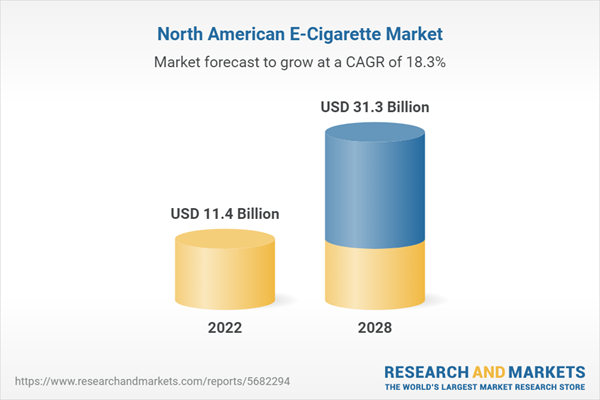E-cigarettes, also known as vape pens and e-vaping devices, are battery-operated electronic devices that simulate the experience of smoking cigarettes. They deliver dosages of vaporized nicotine or flavored solutions for being inhaled by the user. Most of these cigarettes consist of a heating element (atomizer); a mouthpiece that is used for inhaling; and a reservoir which helps in holding the liquid solution. As e-cigarettes do not burn tobacco that generates tar and carbon monoxide, they are considered relatively safer than conventional cigarettes. In recent years, they have gained immense traction, especially among young adults and adolescents, owing to the aggressive promotions by manufacturers worldwide.
North America e-cigarette market is currently driven by several factors. The increasing awareness among individuals about the harmful effects of conventional cigarettes and their growing willingness to quit smoking tobacco products are catalyzing the demand for e-cigarettes in the region. Moreover, manufacturers are introducing new-generation products that offer different strengths of nicotine and enable users to refill the cartridge. In addition to this, the availability of different flavored e-cigarette variants including mint, menthol, chocolate, bubble gum and fusions of other fruits and flavorings are attracting a large number of consumers. Apart from this, the easy availability of e-cigarettes across the well-distributed retail sector has further escalated the market growth in the region.
Key Market Segmentation:
The publisher provides an analysis of the key trends in each segment of the North America e-cigarette market report, along with forecasts at the regional and country levels from 2023-2028. The report has categorized the market based on product, flavor, battery mode and distribution channel.Key Regions Analysed
- United States
- Canada
- Analysis for Each Country
Market by Product
- Modular E-Cigarette
- Rechargeable E-Cigarette
- Next-Generation E-Cigarette
- Disposable E-Cigarette
Market by Flavor
- Tobacco
- Botanical
- Fruit
- Sweet
- Beverage
- Others
Market by Battery Mode
- Automatic E-Cigarette
- Manual E-Cigarette
Market by Distribution Channel
- Specialist E-Cig Shops
- Online Stores
- Supermarkets and Hypermarkets
- Tobacconist
- Others
Value Chain Analysis
- Key Drivers and Challenges
- Porters Five Forces Analysis
- Competitive Landscape
- Competitive Structure
- Key Player Profiles
Key Questions Answered in This Report:
- How has the North America e-cigarette market performed so far and how will it perform in the coming years?
- What are the key regions in the North America e-cigarette market?
- What has been the impact of COVID-19 on the North America e-cigarette market?
- What is the breakup of the North America e-cigarette market on the basis of product?
- What is the breakup of the North America e-cigarette market on the basis of flavor?
- What is the breakup of the North America e-cigarette market on the basis of battery mode?
- What is the breakup of the North America e-cigarette market on the basis of distribution channel?
- What are the various stages in the value chain of the North America e-cigarette industry?
- What are the key driving factors and challenges in the North America e-cigarette industry?
- What is the structure of the North America e-cigarette industry and who are the key players?
- What is the degree of competition in the North America e-cigarette industry?
- What are the profit margins in the North America e-cigarette industry?
Table of Contents
Methodology

LOADING...
Table Information
| Report Attribute | Details |
|---|---|
| No. of Pages | 124 |
| Published | September 2023 |
| Forecast Period | 2022 - 2028 |
| Estimated Market Value ( USD | $ 11.4 Billion |
| Forecasted Market Value ( USD | $ 31.3 Billion |
| Compound Annual Growth Rate | 18.3% |
| Regions Covered | North America |









